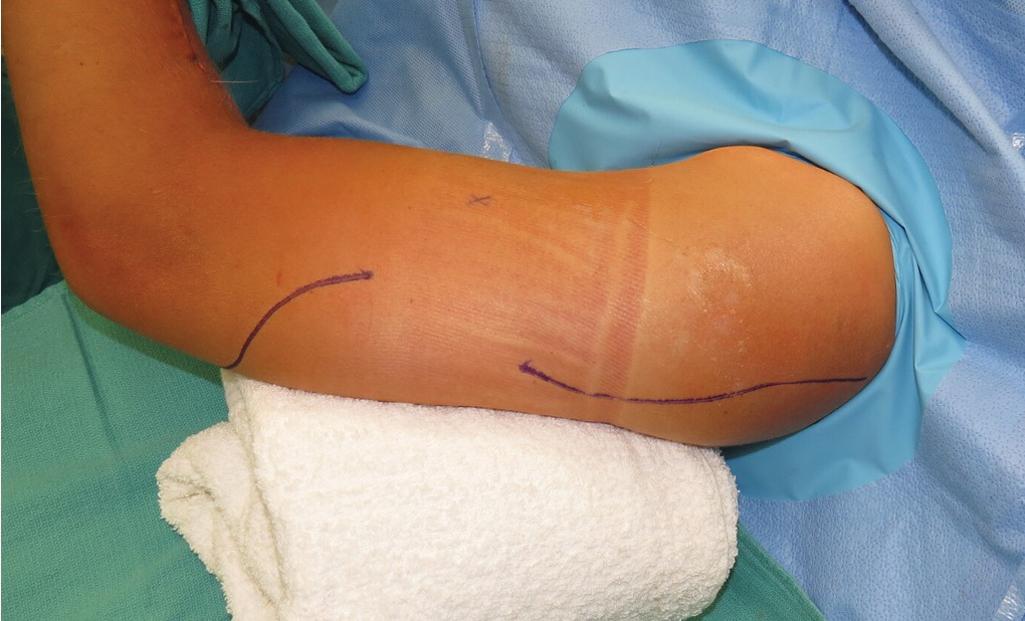Physical Address
304 North Cardinal St.
Dorchester Center, MA 02124
Restoration of elbow extension is critical for patients with tetraplegia. It enables patients to perform various overhead and manual activities and sets the stage for subsequent reconstruction of the upper extremity.
Patients should have a supple elbow joint on examination before transfer.
Patients are typically 12 months out from the initial injury and should have a stable motor examination.
Patients should have realistic expectations, be highly motivated to perform postoperative therapy, and have a stable support system.
Relative contraindications include severe elbow flexion contracture (>30 degrees), uncontrolled spasticity, chronic pain, and psychological instability.
There is a specific segmental innervation (C5 to T1) of muscles of the elbow, forearm, and hand ( Fig. 70.1 ).

An organized examination is performed to document the patient’s muscle function and strength performing elbow flexion, elbow extension, wrist flexion, wrist extension, finger flexion, finger extension, thumb extension/abduction, thumb flexion/opposition, and intrinsic hand function.
The patient’s muscles are graded according to the Medical Research Council (MRC) system (see chapter 69 , Table 69.1). Muscle strength decreases by 1 grade during transfer. Therefore only muscles of grade 4 or greater are available for transfer.
The tetraplegic patient’s hand function and available donor muscles are organized using the International Classification of Surgery of the Hand in Tetraplegia (see chapter 69 , Table 69.2 ).
Passive range of motion (ROM) is tested at the shoulder, elbow, wrist, and fingers to identify any joint or muscle contracture.
A list is constructed of the patient’s functional abilities, priorities for improvement, and available muscles for transfer.
Either the deltoid or the biceps can be transferred for restoration of elbow extension.
Biceps to triceps transfer results in 47% loss of elbow flexion; however, patients report maintained elbow flexion and supination against gravity and no significant functional consequences (Kozin).
Biceps to triceps transfer is stronger and results in antigravity muscle strength (>3) more often compared with deltoid to triceps transfer (Kozin).
Before a deltoid transfer, examine the anterior, middle, and posterior heads. Have the patient sit with arms at sides. Test the anterior, middle, and posterior deltoid by having the patient raise their arms forward, lateral, and posterior against gravity and resistance. The muscle is palpated for bulk and strength.
If strong enough, the posterior half of the deltoid is harvested for transfer. The patient maintains the ability to abduct the shoulder via the anterior head.
Because the biceps muscle transfer results in partial loss of forearm supination and elbow flexion, the strength of the brachialis as an elbow flexor must be verified. Have the patient sit with arms at side and forearms supinated to relax the biceps. The brachialis can be visualized along the lateral arm from the deltoid insertion to the lateral epicondyle. The patient is asked to flex the elbow, and the brachialis can be palpated posterior and lateral to the biceps. The brachialis can occasionally have dual innervation from the musculocutaneous and radial nerves. Therefore one cannot assume that the brachialis is functional if the biceps is functional. The brachialis should be palpated as the patient attempts elbow flexion with the forearm in pronation.
Anteroposterior (AP) and lateral plain x-rays should be performed to rule out arthritic and heterotopic ossification that can restrict motion.
The deltoid muscle has three distinct groups of fibers. These are grouped into the anterior, lateral, and posterior divisions. The deltoid is responsible for shoulder abduction and external rotation.
The groups arise from the clavicle, acromion, and posterior border of the scapular spine, respectively, and insert on the deltoid tuberosity of the humerus.
The vascular supply comes from the posterior circumflex artery and is innervated by the axillary nerve.
This transfer involves the posterior third and half of the lateral fiber groups.
The axillary nerve courses about 5 cm distal to the acromion on the deep surface of the deltoid and must be protected because the posterior half of the middle deltoid is dissected with the posterior deltoid and released from its insertion.
The deltoid to triceps transfer is synergistic. Nevertheless, a tendon graft is necessary to reach the triceps. This transfer requires two suture lines that are susceptible to stretch and rupture. Stretch results in loss of strength, antigravity function, and excursion. Some investigators recommend that a deltoid to triceps transfer is not performed in patients with weak or absent pectoralis function because it could compromise shoulder stability, though this has not been proven.
The procedure is performed with the patient in a lateral decubitus position or supine with the roll under the shoulder.
The site for the fascia lata harvest is prepped and draped.
A lazy S incision is made from the tip of the posterior corner of the acromion to the deltoid insertion of the humerus. Dissection is along the posterior border of the deltoid, leading into its insertion onto the deltoid tubercle (see Fig. 70.1 ).
A separate incision is made posteriorly over the distal third of the humerus to expose the triceps tendon.
Become a Clinical Tree membership for Full access and enjoy Unlimited articles
If you are a member. Log in here